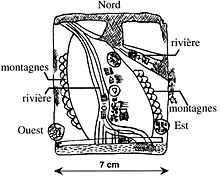Nuzi
Nuzi (Hurrian Nuzi/Nuzu; Akkadian Gasur) at modern Yorghan Tepe (also Yorgan Tepa and Jorgan Tepe), Iraq was an ancient Mesopotamian city 12 kilometers southwest of the city of Arrapha (modern Kirkuk) and 70 kilometers southwest of Sātu Qala, located near the Tigris river.
In the Uruk period levels mudbrick construction occurred and finds included spouted vessels, bevel-rimmed bowls, a small copper animal figurine and a cache of drilled marble stamp and cylinder seals.
[3][1] Early dynastic pottery was found in one pit, from pavements and graves, with no interruption with the following Akkadian Empire occupation.
[4][5][6] It was a provincial seat of a governor known from a clay sealing reading: "Itbe-labba, govern[or] of Gasur" found at Tell Brak in modern Syria.
The Nuzi map is actually one of the so-called Gasur texts, and predates destruction by fire of the city at this end of the Early Bronze Age.
[17] An Ititi was appointed as governor of the northern province at Kazallu by Ur III ruler Shulgi (c. 2094–2046 BC).
[18] The site was occupied to a lesser extent in the Ur III, Isin-Larsa, and [[Old Babylonian periods]] following a sack of the city.
The history of the site during the intervening period is unclear, though the presence of a few cuneiform tablets from Assyria indicates that trade with nearby Assur was taking place.
Note that while the Hurrian period is well known from full excavation of those strata, the earlier history is not as reliable because of less substantive digging.
[20] The tablets of this period indicate that Nuzi was a small provincial town of northern Mesopotamia at this time in an area populated mostly by Hurrians.
Despite the presence of two temples most votive activity at Nuzi in this period is that of household religions with elements of ancestor worship where the eldest son inherits the family cult statue.
[25] Archives that have been exhumed tell us about the royal family, as well as the organization of the internal administration of the palace and its dependencies, and the payments various workers received.
Junior officers of the royal administration had such titles as sukkallu (often translated as "vizier", the second governor), "district manager" (halṣuhlu), and "mayor" (hazannu).
Free subjects of the state were liable to a conscription, the Ilku, which consisted of a requirement to perform various types of military and civilian services, such as working the land.
Originally thought to be extramural residences it is now believed, partly on textual evidence, that there was an outer town with its own wall, now destroyed by modern agriculture.
[43] The vast majority of finds come from the Hurrian period during the second millennium BC with the remainder dating back to the town's founding during the Akkadian Empire.
A discovered sealing read "Saustatar, son of Parsatatar, king of Mitani", being the first, Baratarna, and second, Shaushtatar, rulers of the Mitanni Empire.
[3] In the temple area a number of bronze objects were found, including a statue carved in the round, 9 sickles, 2 sun-discs, 2 crescents, 6 pins, 1 bell, 2 bracelets, and hundreds of small beads.
[2] In 1948, archaeologist Max Mallowan called attention to the unusual pottery he found at Nuzi, associated with the Mitanni period.




